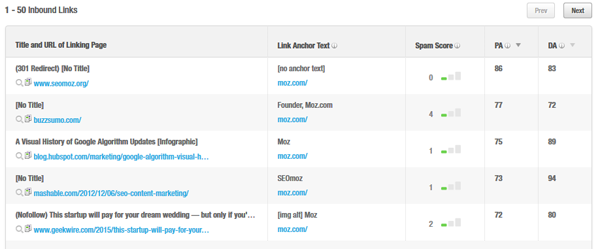We're Not With Them...Learn How to Disavow

The phrase "guilty by association" rings very true in search engine optimization (SEO).
Who a company links to and what digital properties link to them is a key part of how search engines understand the quality, authority and relevancy of an online enterprise. Since a link portfolio is crucial to a brand's rankings, it's imperative that those responsible for SEO within their organizations know how to disavow backlinks that could be negatively impacting their ranking initiatives. This is because even those who practice natural link-building efforts could, over time, have unnatural links pointing to their site.
To show Google that you are not with "them," follow these steps (mainly intended for smaller enterprises):
Caution: It's always best to consult a SEO professional!
Step 1
Use a backlink checker to get a clear idea of what sites are linking to yours. Moz offers a free backlink checker (see image) to get a quick glance at backlinks but it's subscription plans are much more robust, including the ability to track links over time, access up to 10,000 links, get social data and run unlimited reports. A high spam score and low page and domain authority will be links to watch but the links of most concern are those from low-quality directories, those that have been paid for or are completely spammy and irrelevant (like adult or gambling websites). Other ways to download links is through Google's Search Console and other freemium services like majestic.com and ahrefs.com. These services alone, or a combination of them, will allow a Web master to either go back in time to understand what links need to be disavowed or get a better handle on new links by continuously monitoring their profile.

Step 2
Once the links have been downloaded from one source or a multitude of sources, SEO professionals should create a Google Doc spreadsheet that allows them to track what links need action. By using Google Docs, multiple team members can access the file, make changes and keep disavow initiatives moving forward in real-time.
Step 3
Before looking to Google for help, brands should request removal from the site linking to them. It's common practice to email a company to ask for link removal - it happens across industries and white-hat Web masters will think nothing of it. Word to the wise (read more here) is to send this link removal request from a company email address so that the recipient knows it's a brand representative and not a person trying to engage in negative SEO and ousting their competition.
Step 4
While Google warns that it's Disavow tool is an advanced feature and should only be used with caution, it allows Web masters with a considerable amount of spammy, artificial and/or low-quality links pointing at their site to regain some control. Again though, Google states that it can assess which links to trust without additional guidance, so most normal or typical sites will not need to use this tool. If smaller enterprises are unable to make progress from step 3 and are sure a spammy link(s) is giving their site trouble, then they should proceed with Google's Disavow tool by uploading a list of links to disavow (this is where the spreadsheet will come in handy, although Google has certain formatting rules - see image).

While the steps for disavowing "bad" links are provided above in a very (very) high-level manner, it's important that small enterprises understand how critical their link portfolio is to both the success and failure of their ranking initiatives. It's best to seek professional help from an in-house SEO professional or a reputable outside agency before conducting any disavow processes.

Subscribe to Our Newsletter!
Latest in Marketing








